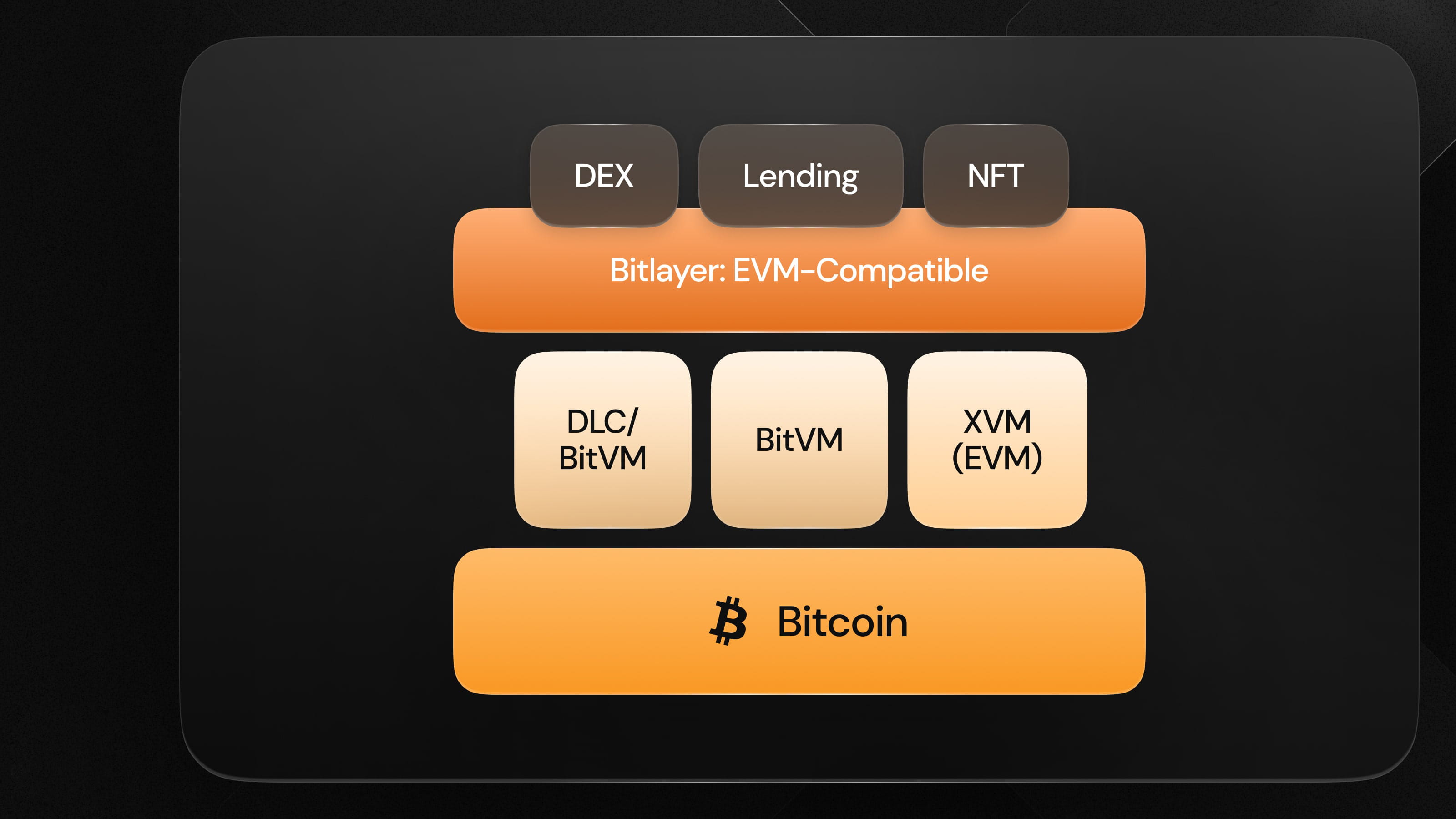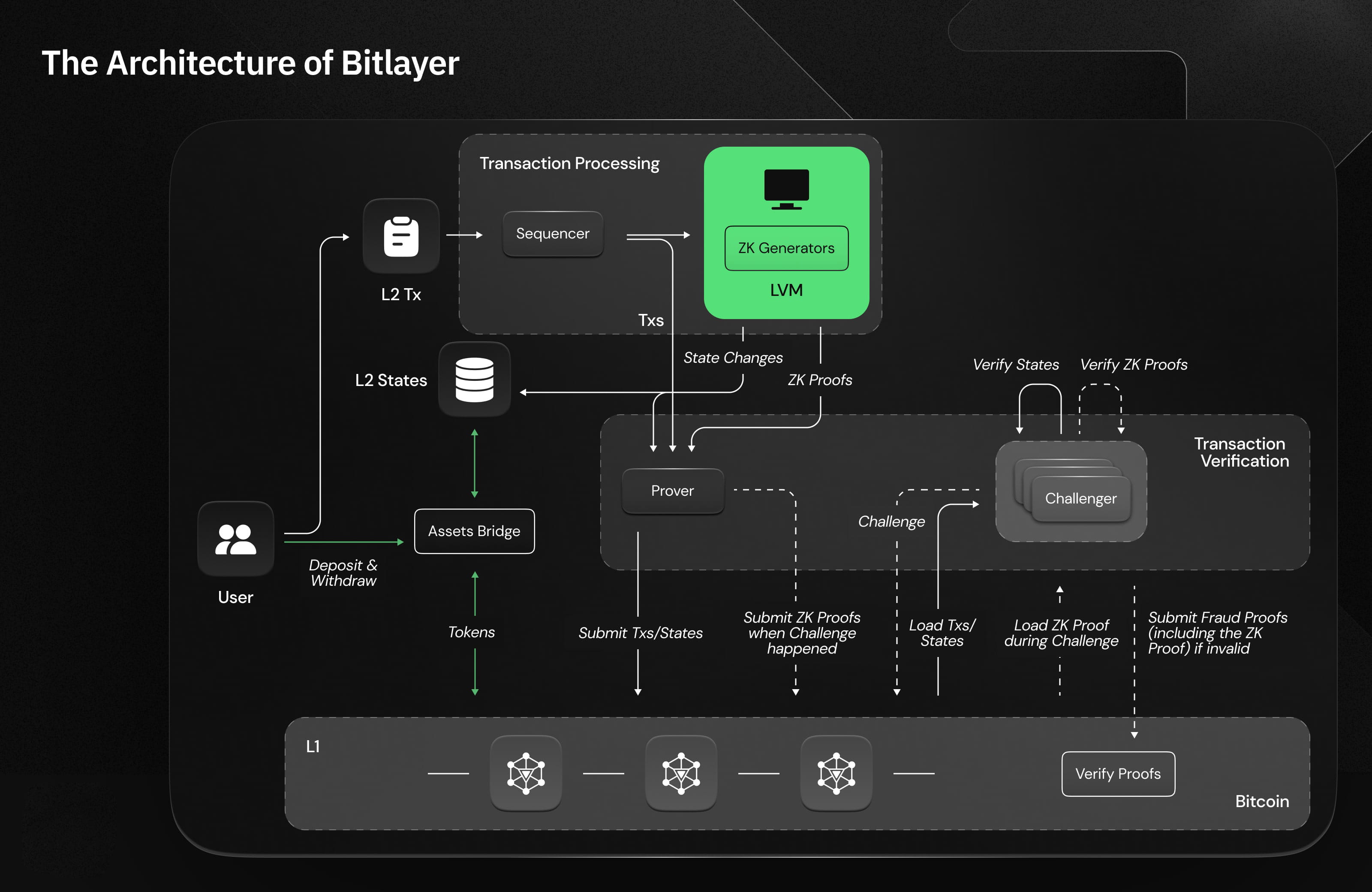Bitcoin's market share in the DeFi space continues to grow, with over $4.3 billion in BTC locked across various protocols as of 2024. As new Layer 2 (L2) solutions are developed and launched, Bitcoin DeFi is likely to play an increasingly important role in the future of decentralized finance.
Bitlayer is a new Bitcoin L2 aimed at fitting the nature of this network while allowing developers to launch Bitcoin-powered applications without needing to hard fork or affect its base layer.
What is Bitlayer?
Bitlayer is a complete Turing Layer 2 for Bitcoin, designed to help the Bitcoin network scale and expand its ecosystem with new use cases while leveraging the security of the network.
With the first version of the mainnet launched, Bitlayer is using the experimental BitVM solution invented by Bitcoin developer Robin Linus to achieve Bitcoin's finality, a trustless bridge, and support for multiple virtual machines.
This allows smart contract developers on other blockchains to move their projects to Bitlayer using familiar tools.
Meanwhile, if the project succeeds, you will have access to advanced dApps supported by Bitlayer, leveraging Bitcoin's security. This can be achieved not only through wallets compatible with the Ethereum Virtual Machine (EVM) but also through other wallets like Xverse.
L2 also aims to provide more competitive fees, paid in BTC as the native token of Bitlayer. You can now experiment with Bitlayer's features on the test network environment.
Key Features of Bitlayer
The Bitlayer network architecture is built on three main features anchored by Bitcoin's finality.

Bitcoin Security with OPVM
Optimistic Virtual Machine (OPVM) is the first layer of verification for transactions on Bitlayer with Bitcoin's finality. Using the optimistic aggregate principle, OPVM assumes transactions are valid unless proven otherwise.
This assumption helps speed up transaction processing, reduce resource consumption, and make the network operate more efficiently. OPVM scales transaction throughput and user experience.
Trustless Bridge for Safe Asset Transfers
A trustless bridge is a key part of Bitlayer, designed to support secure and decentralized asset transfers between Layer 2 and Bitcoin.
Two-way pegging system
It uses BitVM and Optimistic Discreet Log Contracts (OP-DLC) to create a two-way pegging system.
Challenge-response protocol
This bridge uses a challenge-response protocol and binary circuit commitments to minimize on-chain activity while still maintaining decentralization.
Off-chain computation
Complex computations are handled off-chain, allowing for quick asset movement between layers, while ZK proofs help make them reliable.
Real-Time EVM Compatibility
Bitlayer supports real-time compatibility with Ethereum Virtual Machine, allowing Ethereum-based applications to run on its network without modification. Familiar development tools facilitate a smooth transition, attracting a broader developer community to the platform.
EVM compatibility provides Ethereum developers with the best infrastructure to move their applications to Bitlayer and benefit from the most secure blockchain, Bitcoin.
How Does Bitlayer Operate? An In-Depth Look
Bitlayer aims to bring more utility to Bitcoin by adding the capability to process verification computations and run complex logic calculations while still relying on Bitcoin's finality for the network.
In simple terms, Bitlayer provides developers with the tools and infrastructure to deploy complex smart contracts on this platform as well as an environment to run smart contracts.
Understanding the architecture of Bitlayer can be challenging, but we have analyzed it here for you.
Bitlayer network architecture diagram

1. Initiation and transaction arrangement
To begin, you need to initiate transactions through various smart contracts on Bitlayer. These transactions are received by the sequencer in Bitlayer, which is responsible for sorting and preparing them for processing.
Communication protocol
The sequencer uses JSON-RPC to communicate. JSON-RPC is a way for computers to communicate over the network using simple text format, making it easier for them to send requests and receive responses.
2. Transaction processing
Transactions are then processed in XVM (Extended Virtual Machine), capable of performing complex computations, turning Bitlayer into a complete Turing network.
State management
The current state (e.g., the value of a unit) of all computations is maintained and continuously updated, ensuring that the network accurately reflects the outcomes of transactions.
3. Commitment and Verification
In the next step, state differences are prepared for verification. This means accounting for the state differences of the network before and after the transaction.
Data accessibility
The Data Availability Committee (DAC) ensures that all necessary data to verify these state differences is accessible.
This maintains the integrity and transparency of the network.
4. Verification and Finality
In the next step, transactions are aggregated, and ZK-proof is generated for them.
Verification
Transactions are verified using optimistic no-knowledge mechanisms between Prover and Challenger, tasked with confirming the accuracy of the state differences.
Final state submission
The final verified state is then sent back to the Bitcoin blockchain for finalization.
5. Ensuring Asset Transfers
The Bitlayer team uses DLC (Discreet Log Contracts) along with BitVM to secure asset transfers.
DLC
DLC is a type of contract that executes transactions on the Bitcoin blockchain once certain pre-defined conditions are met in the smart contract.
Minimize risks
This reduces risks associated with multi-party computation and threshold signature schemes, where the security of assets lies on the platform. Now, with DLC, this bridge is much more trustworthy as it eliminates excessive stakeholders.
After grasping the architectural framework and operational processes of Bitlayer, it's time to highlight the key features that make Bitlayer stand out in the blockchain space.
What makes Bitlayer scalable, secure, and interoperable?
Now that we know about the key features and architecture of Bitlayer, let's take a look at the components that enhance Bitlayer's scalability, security, and interoperability.
Layered Virtual Machine (LVM)

LVM separates the execution of smart contracts from generating zero-knowledge proofs, allowing for support of various proof systems like ZK-STARK and ZK-SNARK.
Processing and verifying transactions
Combining Sequencer, LVM, and the optimistic no-knowledge mechanism to process transactions efficiently while adhering to network rules.
Data Availability Committee (DAC)
The Data Availability Committee (DAC) ensures that all necessary data to verify transactions is accessible and shareable across the network.
By preventing data concealment attacks and maintaining transparency, the DAC plays a crucial role in protecting the integrity of the Bitlayer network. It ensures that participants can trust the system and rely on its data for accurate processing.
Support for multiple virtual machines
Bitlayer supports multiple virtual machines, including CairoVM, SolVM, MoveVM, along with XVM and EVM. This flexibility allows developers to freely choose the virtual machine and programming language that best suits their needs.
The combination of LVM, DAC, and multi-VM support makes Bitlayer a flexible and powerful Layer 2 for Bitcoin.
LVM handles and verifies transactions efficiently, while DAC ensures the reliability of the system by maintaining data transparency. Finally, Bitlayer's ability to support multiple virtual machines (VM) expands the network's appeal by addressing diverse developer needs.
What can you find in the Bitlayer ecosystem?
Since the launch of mainnet V1, dozens of dApps have been launched on Bitlayer. Here are some of the most exciting dApps that you can access with your Bitlayer Xverse wallet.
The foundation
Bedrock is a liquidity resting protocol, bringing multi-asset staking features to the Bitlayer ecosystem. This protocol allows you to earn profits through synthetic tokens like uniBTC and uniETH while benefiting from Bitlayer's secure infrastructure.
bitSmiley
bitSmiley introduces decentralized finance to Bitcoin with stablecoins, lending, and derivative products supported by Bitlayer. bitSmiley has contributed to enhancing Bitcoin's role in DeFi, with total assets locked now reaching $30 million.
Ordzaar
Ordzaar is the first Bitcoin NFT marketplace in Asia, specializing in minting and trading Bitcoin Ordinals. This platform provides a user-friendly environment for artists and traders with drag-and-drop functionality and no platform fees.

